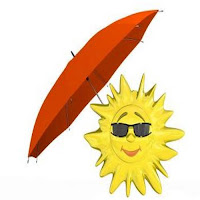How to Survive Hurricanes, Hurricane Safety Tips, Preparation
WHAT IS A HURRICANE?
Hurricanes
are large, swirling storms. They produce winds of 119 kilometers per hour (74
mph) or higher. That's faster than a cheetah, the fastest animal on land. Winds
from a hurricane can damage buildings and trees.
Hurricanes
form over warm ocean waters. Sometimes they strike land. When a hurricane
reaches land, it pushes a wall of ocean water ashore. This wall of water is
called a storm surge. Heavy rain and storm surge from a hurricane can cause
flooding.
Once
a hurricane forms, weather forecasters predict its path. They also predict how
strong it will get. This information helps people get ready for the storm.
There
are five types, or categories, of hurricanes. The scale of categories is called
the Saffir-Simpson Hurricane Scale. The categories are based on wind speed.
Category
1: Winds 119-153 km/hr (74-95 mph) - faster than a cheetah
Category
2: Winds 154-177 km/hr (96-110 mph) - as fast or faster than a baseball
pitcher's fastball
Category
3: Winds 178-208 km/hr (111-129 mph) - similar, or close, to the serving speed
of many professional tennis players
Category
4: Winds 209-251 km/hr (130-156 mph) - faster than the world's fastest
rollercoaster
Category
5: Winds more than 252 km/hr (157 mph) - similar, or close, to the speed of
some high-speed trains
FEMA
SAFETY GUIDELINES FOR HURRICANES
Before a
Hurricane
1.Make
plans to secure your property. Permanent storm shutters offer the best
protection for windows. A second option is to board up windows with ⅝” marine
plywood—cut to fit and ready to install. Tape does not prevent windows from breaking.
2.Install
straps or additional clips to securely fasten your roof to the frame structure.
This will reduce roof damage.
3.Trim
trees and shrubs around your home to minimize the risk of broken branches and
debris.
4.Clear
loose and clogged rain gutters and downspouts to prevent misdirected flooding.
5.Determine
how and where to secure your boat.
6.Fully
fuel your vehicles.
7.Consider
building a safe room.
8.Keep
articles in your basement elevated to avoid damage from even minor flooding.
9.Think
about what you might need if you are isolated for a number of days and must endure a power outage.
10.Keep
a well-stocked Emergency Survival Kit make sure you have 2-3 water filter straws
in your KIT in case of the worst situation that the hurricane lingers longer
than expected and you are running out of all food supply and clean water. If
your don’t have you can get them easily from Amazon. They
hydrate your body and keep you alive before food supply comes.
During a Hurricane
If
a hurricane is likely in your area, you should:
1.Stay
informed by monitoring the storm via radio, TV, and internet.
2.Secure
your home, close storm shutters, and secure outdoor objects or bring them
indoors. Objects such as lawn furniture, trash barrels, hanging plants, toys,
and even awnings can be broken and picked up by strong winds and potentially
become a projectile.
3.Turn
off utilities if instructed by authorities to do so. Otherwise, turn the
refrigerator thermostat to its coldest setting and keep its doors closed.
4.Turn
off propane tanks.
5.Avoid
using the phone, except for serious emergencies.
6.Have
a certain amount of cash available. If power is lost, ATMs may not be working.
7.Moor
your boat if time permits.
8.Ensure
a supply of water for sanitary purposes such as cleaning and flushing toilets. 9.Fill the bathtub and other large containers with water.
10.Close all interior doors—secure and brace external doors.
11.Keep curtains and blinds closed. Do not be fooled if there is a lull; it could be the eye of the storm—winds will pick up again.
12.Take refuge in a small interior room, closet, or hallway on the lowest level.
13.Lie on the floor under a table or another sturdy object.
14.Stay indoors and away from windows and glass doors.
14.Stay indoors and away from windows and glass doors.
You
should evacuate under the following conditions:
1.If
you are directed by local authorities to do so. Be sure to follow their
instructions.
2.If
you live in a mobile home or temporary structure—such shelters are particularly
hazardous during hurricanes—no matter how well fastened to the ground.
3.If
you live in a high-rise building—hurricane winds are stronger at higher
elevations.
4.If
you live on the coast, on a floodplain, near a river, or on an inland waterway.
5.If
you feel that you are in danger.
SOURCE:
NASA&FEMA&FAMER'SALMANAC





Comments
Post a Comment